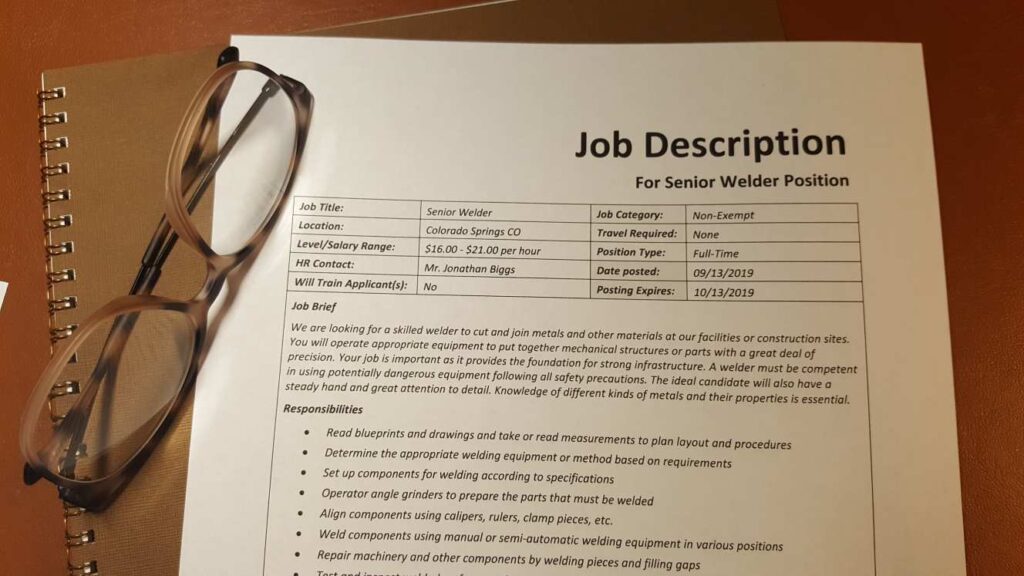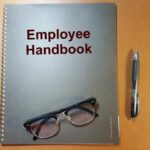In today’s litigious marketplace, employees are often hired with a checklist of tasks, a glossed-over generic job description or nothing at all. Then they are expected to “mind read” the owner, CEO, or manager to figure out what they were really hired to do. If they are terminated for “not doing the job”, the owner or CEO now has a large legal issue to face regarding fighting the ex-employee’s ability to collect Unemployment Insurance, and potentially even wrongful termination. Like the Employee Handbook, a job description (also known as position description) is a must for every single employee in the organization.
The Society for Human Resources Management (SHRM) notes that writing a job description, sharing it with the employee and having them sign that they understand the duties involved can potentially help the employer avoid legal issues.
Some examples of potential issues that could arise without a job description are knowing and describing the necessary safeguards to comply with the Occupational Safety and Health Act (OSHA) or determining how to make reasonable accommodations to follow the laws of the Americans with Disabilities Act (ADA).
Advantages of a Job Description
“Unfortunately, not all employers, hiring managers or companies value a well-developed job description. Therefore, it’s critical to understand the rewards – along with the mitigating risks that apply to federal, state and local laws – of an effective job description.”
– Mary Anne Kennedy, BLR webinar.
A good job description should enable anyone who reads the document to have a clear understanding of the purpose, duties, and responsibilities of that job. There are many significant advantages to having job descriptions.
Gap Analysis and Planning
The Gap or Job analysis and people planning are critical to the success of the organization. Whether you are adding just one or several employees, executing and measuring success while staying financially sound is critical to meeting the goals and objectives of the organization.
The important factors in gap analysis and planning involve the understanding of what current skills are available, what skills need to be sourced, and what skills can be developed internally. A full job description list across an organization shows all the roles and skills required to get the job done. This allows for current, future and emergency planning.
The primary role of a job description is to match the performance evaluation to the skills required to get the job done. The idea that poor performance can be mitigated through training and development is a significant change from motivating an employee to better performance through discipline. By using the job description to identify areas where additional training is needed, both motivates and is measurable.
Job descriptions can also look at the role of the position within an organization, and assist in the career path so that recruitment is forward-looking to future roles. Hiring managers can then consider internal candidates who are not just a good fit for a current vacancy but also may provide consideration of the individual for future advancement.
Recruitment
A good job description makes it easier to recruit qualified employees. Well-written job descriptions serve as a communication tool which allows the employer, employees and recruitment candidates to clearly understand their duties, expectations, required experience and educational credentials as the fundamental framework for their job. It also removes the ability for the employee to interpret the job as they see fit, swimming in a sea of tasks that may not even be job-related, or do not add value to the overall business strategy. Job descriptions provide the employee with a clear focus on what tasks are important and where they are expected to spend their time.
In addition, the candidates can assess their skills and experience against these requirements. At the same time, the employer can refer back to the job description during the screening process to analyze whether an applicant qualifies for the position and if additional training might be necessary.
Recruiting well can improve both internal and external recruitment, and retain and motivate the best talent by ensuring that employee expectations are aligned with business expectations.
Job descriptions help owners, CEOs, human resources professionals and recruiters write effective job ads and interview questions.
Job Descriptions and Internet Searches
A job description acts as a powerful tool for speeding up the job search process. By incorporating a specific set of targeted keywords and phrases into a job description, potential candidates using search engines or job boards like indeed can be quickly directed to a specific job advertisement that contains similar or identical keywords or phrases.
As job advertisement websites continue to expand, the ability to search for a specific position or positions based on keywords, phrases or terminology is invaluable. Having a job description attached to a specific position is the primary facilitator of this process.
Developing New Employee Orientation
Anonymous
“If your job is to tell me how to do my job, you should at least know how to do my job first.”
When the employer fully understands the job duties, a job description can make sure that nothing is left out when putting together the orientation and onboarding plan for the new hire. Since orientation and onboarding are one of the key critical factors for active employee engagement, retention, and positive cultural environment, the job description gives the employer and new hire a complete picture of the role when welcoming a new employee to the organization.
Manage Staff
A good job description is an essential reference tool for disputes among employees, as well as between management and employees. It provides the employer with a structure to ensure that the necessary activities, duties, and responsibilities of the business are covered by one job or another. A significant factor of a good job description is it provides continuity of understanding of a job role, regardless of who is doing the job of managing the staff.
Performance Reviews
Job descriptions assist managers during performance reviews to accurately evaluate an employee’s ability to perform the job. They minimize the appearance of conflict by providing objectivity in assessing employee performance. An accurate assessment of job performance may be determined by comparing the employee’s actions against job specifications and performance goals.
Compensation Data
Direct compensation for any job should never be identified in the job description. The job description gives the employer the opportunity for research to determine the market value of that role before it is filled by anyone. It also offers the opportunity to assess the internal value to see how it fits within your financial plan, and the compensation structure compared to other jobs. Assessing where the job falls within any existing pay structure is imperative so that the employer doesn’t create inequity or comparison issues when filling the role.
Training and Development
What skills are required to get the job done? Does the employee have the knowledge, skills, abilities and attitude (KSAAs) to provide added value? Is the new hire a good fit, or will they need some additional training to be a great fit? The job description and competencies help identify development needs.
Legal Compliance
Although job descriptions are not required by law, they help ensure legal compliance with regulations and laws. Employers often find themselves in situations where an employee asks for an accommodation based on a disability or argues that they are eligible for overtime pay. Job descriptions serve as the first line of defense when questions about these situations arise.
Regulatory compliance relies on knowing what an employee must be able to do, and/or under what conditions they can work. These regulatory requirements and compliance include:
- Equal Employment Opportunity (EEO) – The job description allows the employer to conduct a fair interviewing and hiring process without excluding any potential candidates.
- Americans with Disabilities Act – The job description can be an essential component in determining the essential functions of the job when working out reasonable accommodations for disabled individuals. It should directly specify the essential and non-essential job functions, and be periodically reviewed for accuracy.
- Title VII of the Civil Rights Act of 1964 – This prohibits unlawful discrimination against any individual with respect to hiring, compensation, conditions, and privileges of employment based on race, color, religion, sex or national origin.
- Equal Pay Act of 1963, Worker’s Compensation – This law is aimed at abolishing disparity based on gender. Obviously, the job description should not indicate that there are any gender pay differences or bias.
- Occupational Safety and Health Act – By describing the working conditions in the job description, the employer specifically lays out how the job is performed. This is also an opportunity to note whether the employee will need to be able to perform hazardous activities.
- The Fair Labor Standards Act – The job description both governs and ensures proper classification of roles as exempt versus non-exempt, which affects the overtime eligibility of the person filling that role.
Some aspects of job descriptions can be negative. Their downsides might include:
- Becoming outdated in a fast-paced, changing, customer-driven work environment – Review job descriptions quarterly to ensure there is accurate data. Be aware that it is considered unfair if the employee receives new goals and is expected or responsible for every task listed in the original employee job description, especially if the goals and job accomplishments are tied to salary or bonus. The employer must look at where the employee is investing their time, and prioritize. If the employee job description provides an inaccurate picture, change the job description.
- Doesn’t have enough flexibility to allow individuals to “work outside of the box”– Job descriptions must have some flexibility so that employees are comfortable with cross-training, such as helping another team member accomplish a task, and making appropriate decisions to serve the customers. It is important that the employer supports the employee’s ability to make reasonable changes to stretch their limits where appropriate.
- Doesn’t always provide for reviews of an employee’s day-to-day work – Employee job descriptions are an integral part of the performance management and evaluation system and are used for salary increases, promotions, and bonus eligibility. Therefore, they must not only identify regular goals and objectives, but they must also be a reference for determining how an employee spends their time at work daily.
- They sit in a file cabinet or drawer and therefore are a waste of time – Job descriptions must be an integral part of the hiring and operations process of any business.
Creating a Well Written Job Description
The job description is the very first impression made with a potential future employee.
Formatting
The job description should be presented in a format that will attract applicants, as well as easy to file and maintain.
- The text should be 12 point; font Times Roman or Arial (no smaller)
- Headers or Sections should be 14-16 point; font Times Roman or Arial (no bigger)
- Line spacing should be easy to read at 1.15 or 1.5
- The text should be black
- Use solid bullets in black for list of tasks
- If tasks are in different categories, use italics without bullets to separate the categories (i.e., Marketing; Web Design; Social Media, etc.), with tasks bulleted under each heading
- Begin each task with an action verb that explains the activities (i.e., controls, operates, designs, evaluates, develops, supervises, trains, etc.)
Job Description Sections
Job Title – The job title is what will naturally catch the eye of the ideal candidate. It should include what the candidate will do (i.e. sales) and their level within the company (i.e., associate, manager, vice president, etc.). Refrain from catchy titles such as “sales ninja” instead of “sales director”, or “design unicorn” instead of “lead designer”. Remember- job titles impact internet search engines.
Location – The location of the position should be displayed on the front page of the job description so that any potential employee can see it.
Role Objective – Before listing the exact tasks and responsibilities, it is important to provide a high-level summary of what the job entails. Outline why the company is hiring for the position, goals to accomplish, and how the candidate is expected to achieve them. The role objective is a nice lead in to the exact responsibilities.
Role Responsibilities – Use the role responsibilities to outline the day-to-day tasks and responsibilities in bullet points. List exactly what the new hire will be doing. Write job responsibilities using terminology that matches the profession.
Desired Experience and Qualifications – Be specific about the years of experience required to do the job. Be careful to not overstate the number of years needed, otherwise candidates who are otherwise qualified may not apply.
Identify the degrees, certifications and other educational requirements needed, and be sure to state if so many years of experience will qualify for education equivalents.
Be specific about the skills required (i.e., ability to speak Spanish; able to type 75 words per minute; ability to operate a forklift, etc.).
Compliance Required Information – Here is where you would list physical requirements (i.e., must be able to stand long periods of time; must be able to lift 50 lbs., etc.). Accommodations for the disabled must be added.
Summary
Still not convinced that job descriptions are needed? Having job descriptions can be the difference between winning or losing employment-related legal battles. This means that job descriptions could save you thousands, even millions of dollars in legal fees and settlements. Whether unemployment or unfair employment practices claims, job descriptions are often the first defense, giving the employer leverage against such claims.
Bottom line- creating and maintaining job descriptions isn’t difficult, however, it can be time-consuming (only once if maintained). In fact, sometimes businesses use the development of job descriptions as a means of opening a new line of communication with employees.
Entrepreneurs and small business may create job descriptions as part of their strategic plan in order to identify goals, objectives, and tasks to get the job done. Ultimately, job descriptions may be used as a useful tool to guide many critical employment decisions, and serve as an important consideration in the defense of administrative actions and lawsuits.
A job description will help you make sound hiring and operation decisions. Having the right people with the right knowledge, skills, abilities, and attitude at the right time are critical to the future success of any business.
Resources:
Indeed is a great place to start. Just be sure all the legal compliance and other elements are there. Attached are a few job description templates for your consideration.
Guest post by: Marcy Fletchall the former CEO and Senior HR Consultant for HRchitects, Ltd. Marcy is a former SCORE colleague and a Human Resources maven. I am a super fan of her work. She currently operates Kaleidoscope Compass a site that helps users navigate business opportunities.












